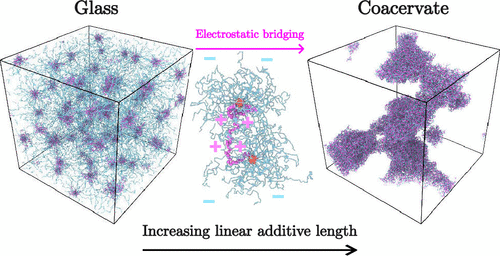溶液中高电荷星形线状聚电解质混合物的结构构象表征
IF 5.2
1区 化学
Q1 POLYMER SCIENCE
引用次数: 0
摘要
远程静电相互作用为调整溶液中聚合物胶束和软胶体的构象和相行为提供了独特的机会,但由于更高的合成、表征和模拟复杂性,它们的影响仍未得到充分研究。我们最近发现,由于远距离静电相互作用,具有长而带电的聚合物臂的胶束在不同浓度下表现出独特的柔软性和玻璃状行为,并建立了分子动力学模型来验证实验结果。在这里,我们进一步探索了我们的新体系,我们研究了高电荷星形聚电解质(spe,模拟球形胶束)和相反电荷线性聚电解质(LPEs)的混合物,使用分子动力学模拟和流变学验证。LPE的加入对SPE的大小和构象有强烈的影响,它在SPE的边界球内引入了电荷中和,导致根据LPE的长度和浓度收缩或膨胀。长lpe在多个spe之间形成桥接,在高电荷比下诱导聚类并促进液-液相分离,触发玻璃-凝聚转变。实验流变学证实,LPE的增加首先降低了粘度,然后急剧增加了粘度,同时系统的目视相分离也得到了验证,验证了模拟结果。这些发现强调了静电相互作用、链熵和填充效应之间的相互作用,为在软材料设计中如何调整多电解质混合物以控制络合和相行为提供了见解。本文章由计算机程序翻译,如有差异,请以英文原文为准。

Characterizing the Structural Conformation of Highly Charged Star-Linear Polyelectrolyte Mixtures in Solution
Long-range electrostatic interactions provide unique opportunities to tune the conformation and phase behavior of polymeric micelles and soft colloids in solution, but their effects remain understudied due to the higher synthesis, characterization, and simulation complexity. We recently showed that micelles with long, charged polymer arms exhibit unique softness and glassy behavior at varying concentrations due to long-range electrostatic interactions, and developed a molecular dynamics model to validate the experimental results. Here we further explore our new system, and we investigate mixtures of highly charged star polyelectrolytes (SPEs, mimicking spherical micelles) and oppositely charged linear polyelectrolytes (LPEs) using molecular dynamics simulations and rheological validation. SPE size and conformation are strongly affected by LPE addition, which introduces charge neutralization within the SPEs’ bounding spheres, leading to shrinkage or expansion depending on the LPE length and concentration. Long LPEs form bridges between multiple SPEs, inducing clustering and promoting liquid–liquid phase separation at high charge ratios, triggering a glass-to-coacervate transition. Experimental rheology confirms that increasing the LPE initially decreases, then drastically increases viscosity, together with visual phase separation of the system, validating the simulation results. These findings highlight the interplay between electrostatic interactions, chain entropy, and packing effects, offering insights into how polyelectrolyte mixtures can be tuned for controlled complexation and phase behavior in soft materials design.
求助全文
通过发布文献求助,成功后即可免费获取论文全文。
去求助
来源期刊

Macromolecules
工程技术-高分子科学
CiteScore
9.30
自引率
16.40%
发文量
942
审稿时长
2 months
期刊介绍:
Macromolecules publishes original, fundamental, and impactful research on all aspects of polymer science. Topics of interest include synthesis (e.g., controlled polymerizations, polymerization catalysis, post polymerization modification, new monomer structures and polymer architectures, and polymerization mechanisms/kinetics analysis); phase behavior, thermodynamics, dynamic, and ordering/disordering phenomena (e.g., self-assembly, gelation, crystallization, solution/melt/solid-state characteristics); structure and properties (e.g., mechanical and rheological properties, surface/interfacial characteristics, electronic and transport properties); new state of the art characterization (e.g., spectroscopy, scattering, microscopy, rheology), simulation (e.g., Monte Carlo, molecular dynamics, multi-scale/coarse-grained modeling), and theoretical methods. Renewable/sustainable polymers, polymer networks, responsive polymers, electro-, magneto- and opto-active macromolecules, inorganic polymers, charge-transporting polymers (ion-containing, semiconducting, and conducting), nanostructured polymers, and polymer composites are also of interest. Typical papers published in Macromolecules showcase important and innovative concepts, experimental methods/observations, and theoretical/computational approaches that demonstrate a fundamental advance in the understanding of polymers.
 求助内容:
求助内容: 应助结果提醒方式:
应助结果提醒方式:


